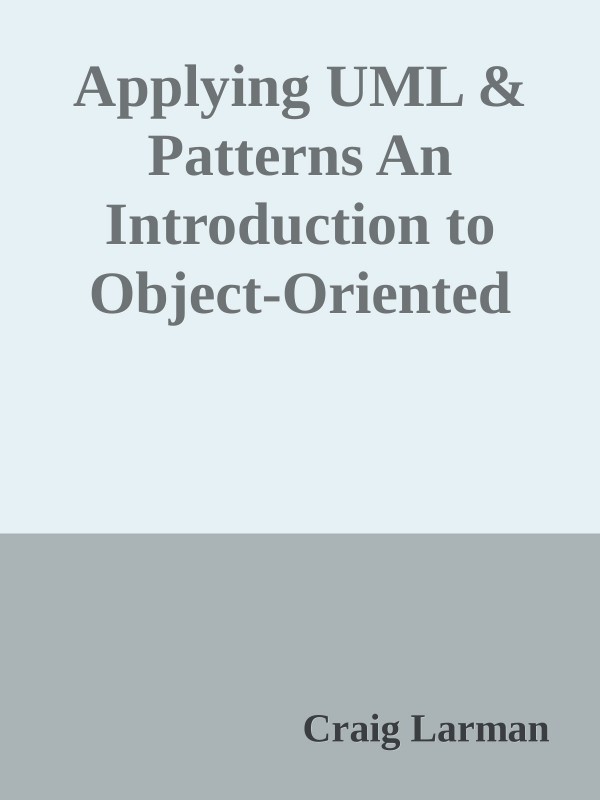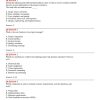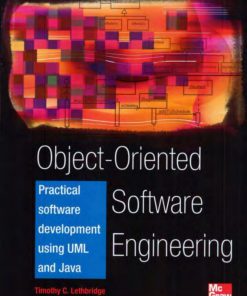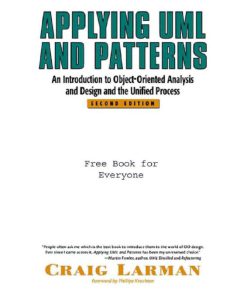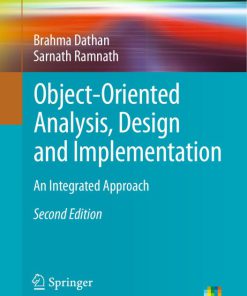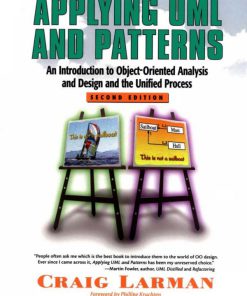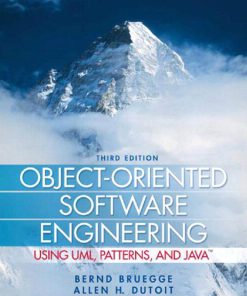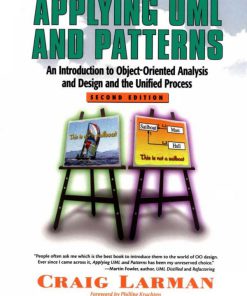Applying UML and Patterns An Introduction to Object Oriented Analysis and Design and Iterative Development 3rd Edition by Craig Larman ISBN 0131489062 9780131489066
$50.00 Original price was: $50.00.$25.00Current price is: $25.00.
Authors:Craig Larman , Series:IT & Computer [229] , Tags:Computer Communication Networks; Information Technology , Author sort:Larman, Craig , Identifiers:Identifiers:isbn-13:9780131489066 , Languages:Languages:eng , Published:Published:Jun 2018 , Publisher:Pearson , Comments:“This edition contains Larman’s usual accurate and thoughtful writing. It is a very good book made even better.â€â€”Alistair Cockburn, author, Writing Effective Use Cases and Surviving OO Projects “Too few people have a knack for explaining things. Fewer still have a handle on software analysis and design. Craig Larman has both.â€â€”John Vlissides, author, Design Patterns and Pattern Hatching “People often ask me which is the best book to introduce them to the world of OO design. Ever since I came across it Applying UML and Patterns has been my unreserved choice.â€â€”Martin Fowler, author, UML Distilled and Refactoring “This book makes learning UML enjoyable and pragmatic by incrementally introducing it as an intuitive language for specifying the artifacts of object analysis and design. It is a well written introduction to UML and object methods by an expert practitioner.â€â€”Cris Kobryn, Chair of the UML Revision Task Force and UML 2.0 Working Group A brand new edition of the world’s most admired introduction to object-oriented analysis and design with UML Fully updated for UML 2 and the latest iterative/agile practices Includes an all-new case study illustrating many of the book’s key points Applying UML and Patterns is the world’s #1 business and college introduction to “thinking in objectsâ€â€”and using that insight in real-world object-oriented analysis and design. Building on two widely acclaimed previous editions, Craig Larman has updated this book to fully reflect the new UML 2 standard, to help you master the art of object design, and to promote high-impact, iterative, and skillful agile modeling practices. Developers and students will learn object-oriented analysis and design (OOA/D) through three iterations of two cohesive, start-to-finish case studies. These case studies incrementally introduce key skills, essential OO principles and patterns, UML notation, and best practices. You won’t just learn UML diagrams—you’ll learn how to apply UML in the context of OO software development. Drawing on his unsurpassed experience as a mentor and consultant, Larman helps you understand evolutionary requirements and use cases, domain object modeling, responsibility-driven design, essential OO design, layered architectures, “Gang of Four†design patterns, GRASP, iterative methods, an agile approach to the Unified Process (UP), and much more. This edition’s extensive improvements include A stronger focus on helping you master OOA/D through case studies that demonstrate key OO principles and patterns, while also applying the UML New coverage of UML 2, Agile Modeling, Test-Driven Development, and refactoring Many new tips on combining iterative and evolutionary development with OOA/D Updates for easier study, including new learning aids and graphics New college educator teaching resources Guidance on applying the UP in a light, agile spirit, complementary with other iterative methods such as XP and Scrum Techniques for applying the UML to documenting architectures A new chapter on evolutionary requirements, and much more Applying UML and Patterns, Third Edition, is a lucid and practical introduction to thinking and designing with objects—and creating systems that are well crafted, robust, and maintainable.« less; « less
Applying UML and Patterns An Introduction to Object Oriented Analysis and Design and Iterative Development 3rd Edition by Craig Larman – Ebook PDF Instant Download/Delivery. 0131489062 ,9780131489066
Full download Applying UML and Patterns An Introduction to Object Oriented Analysis and Design and Iterative Development 3rd Edition after payment
Product details:
ISBN 10: 0131489062
ISBN 13: 9780131489066
Author: Craig Larman
“This edition contains Larman’s usual accurate and thoughtful writing. It is a very good book made even better.”
―Alistair Cockburn,author,Writing Effective Use CasesandSurviving OO Projects“Too few people have a knack for explaining things. Fewer still have a handle on software analysis and design. Craig Larman has both.”
―John Vlissides,author,Design PatternsandPattern Hatching“People often ask me which is the best book to introduce them to the world of OO design. Ever since I came across it Applying UML and Patterns has been my unreserved choice.”
―Martin Fowler,author,UML DistilledandRefactoring“This book makes learning UML enjoyable and pragmatic by incrementally introducing it as an intuitive language for specifying the artifacts of object analysis and design. It is a well written introduction to UML and object methods by an expert practitioner.”
―Cris Kobryn,Chair of the UML Revision Task Force and UML 2.0 Working Group
- A brand new edition of the world’s most admired introduction to object-oriented analysis and design with UML
- Fully updated for UML 2 and the latest iterative/agile practices
- Includes an all-new case study illustrating many of the book’s key points
Applying UML and Patterns is the world’s #1 business and college introduction to “thinking in objects”―and using that insight in real-world object-oriented analysis and design. Building on two widely acclaimed previous editions, Craig Larman has updated this book to fully reflect the new UML 2 standard, to help you master the art of object design, and to promote high-impact, iterative, and skillful agile modeling practices.
Developers and students will learn object-oriented analysis and design (OOA/D) through three iterations of two cohesive, start-to-finish case studies. These case studies incrementally introduce key skills, essential OO principles and patterns, UML notation, and best practices. You won’t just learn UML diagrams―you’ll learn how to apply UML in the context of OO software development.
Drawing on his unsurpassed experience as a mentor and consultant, Larman helps you understand evolutionary requirements and use cases, domain object modeling, responsibility-driven design, essential OO design, layered architectures, “Gang of Four” design patterns, GRASP, iterative methods, an agile approach to the Unified Process (UP), and much more. This edition’s extensive improvements include
- A stronger focus on helping you master OOA/D through case studies that demonstrate key OO principles and patterns, while also applying the UML
- New coverage of UML 2, Agile Modeling, Test-Driven Development, and refactoring
- Many new tips on combining iterative and evolutionary development with OOA/D
- Updates for easier study, including new learning aids and graphics
- New college educator teaching resources
- Guidance on applying the UP in a light, agile spirit, complementary with other iterative methods such as XP and Scrum
- Techniques for applying the UML to documenting architectures
- A new chapter on evolutionary requirements, and much more
Applying UML and Patterns, Third Edition, is a lucid and practical introduction to thinking and designing with objects―and creating systems that are well crafted, robust, and maintainable.
Applying UML and Patterns An Introduction to Object Oriented Analysis and Design and Iterative Development 3rd Edition Table of contents:
Chapter 1: Introduction to Object-Oriented Analysis and Design
- What is Object-Oriented Analysis and Design (OOAD)?
- Overview of Object-Oriented Concepts
- The Role of UML in OOAD
- The Iterative Development Process
- The Importance of Design Patterns
Chapter 2: The Unified Modeling Language (UML)
- Introduction to UML and Its Role in OOAD
- UML Diagrams: Structural vs. Behavioral
- The Basics of UML Class Diagrams
- Use Case Diagrams and Their Role in Capturing Requirements
- Sequence Diagrams, Collaboration Diagrams, and Activity Diagrams
- The Object Diagram and State Diagrams
Chapter 3: Object-Oriented Analysis
- Understanding the Problem Domain
- Identifying Use Cases and Actors
- Requirements Gathering and Analysis Techniques
- Class and Object Identification
- Developing Use Case Realizations and Scenarios
- Modeling the System with UML
Chapter 4: Object-Oriented Design
- The Object-Oriented Design Process
- Key Principles of Object-Oriented Design: Encapsulation, Inheritance, and Polymorphism
- Design Patterns: Overview and Types
- Layered Architecture and Component Design
- Mapping Analysis Models to Design Models
- Using UML to Model the Design
Chapter 5: Iterative and Incremental Development
- Overview of Iterative and Incremental Development
- The Role of Prototyping in Development
- Agile vs. Waterfall Approaches
- Advantages of Iterative Development in OOAD
- Case Study: Iterative Development in Action
- Feedback and Refinement Loops
Chapter 6: The Use Case Model
- Use Cases: Definition and Importance
- Writing Effective Use Cases
- Identifying Use Cases and Actors in a System
- Structuring and Detailing Use Cases
- Use Case Realization and Mapping to Design
- Best Practices for Use Case Modeling
Chapter 7: Domain Modeling and Class Design
- The Role of Domain Models in OOAD
- Identifying and Defining Domain Objects
- Relationships Between Domain Objects: Associations, Aggregations, and Compositions
- Defining Classes and Objects
- Attributes, Methods, and Responsibilities
- UML Class Diagrams in Domain Modeling
Chapter 8: Design Patterns
- Introduction to Design Patterns
- The Catalog of Design Patterns: Creational, Structural, and Behavioral Patterns
- The Strategy Pattern
- The Observer Pattern
- The Factory Method Pattern
- Applying Design Patterns in OOAD
Chapter 9: Object-Oriented Testing and Refactoring
- Testing Object-Oriented Systems
- Unit Testing and Test-Driven Development (TDD)
- Refactoring Techniques in Object-Oriented Design
- Improving Design through Refactoring
- Automated Testing Tools for OO Systems
- Best Practices for Object-Oriented Testing
Chapter 10: Component and Package Design
- The Importance of Component Design
- Creating Reusable Components and Libraries
- Packaging and Organizing Classes into Components
- Component Diagrams in UML
- Deployment and Configuration Management
Chapter 11: Implementing Object-Oriented Systems
- Moving from Design to Implementation
- Mapping Design Artifacts to Code
- The Role of UML in Code Generation
- Best Practices for OO System Implementation
- Tools and Environments for OO Development
Chapter 12: Case Studies and Real-World Examples
- Real-World Applications of OOAD and UML
- Case Study 1: A Business Application
- Case Study 2: A Distributed System
- Case Study 3: An E-Commerce Platform
- Lessons Learned and Best Practices from Case Studies
Chapter 13: Advanced Topics in OOAD and UML
- Design Patterns in Depth
- The Role of Architecture in Object-Oriented Design
- Domain-Driven Design
- Object-Oriented Frameworks and Reusability
- The Future of Object-Oriented Analysis and Design
People also search for Applying UML and Patterns An Introduction to Object Oriented Analysis and Design and Iterative Development 3rd Edition:
object-oriented development
object-oriented design and programming in labview
object-oriented analysis
object oriented data analysis

